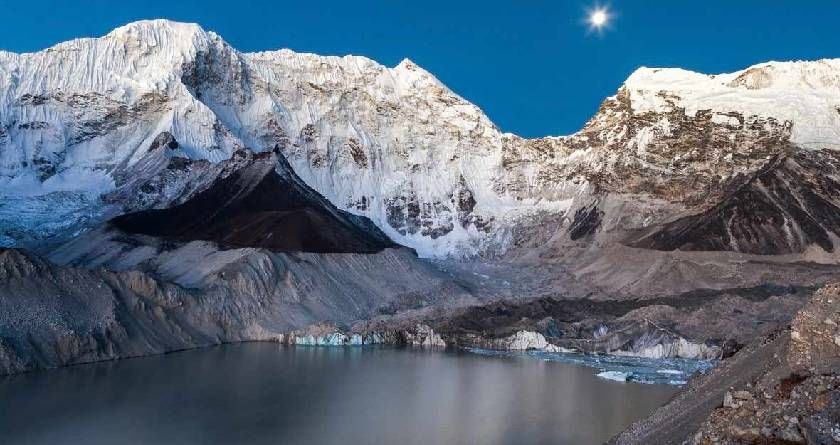Live Classes

Around 15 million people across the world face the risk of sudden and deadly flooding from glacial lakes, which are expanding and rising in numbers due to global warming, according to a new study. More than half of those who could be impacted live in four countries: India, Pakistan, Peru and China.
Research Paper
Published in the journal Nature, the study, ‘Glacial lake outburst floods threaten millions globally’ has been conducted by Caroline Taylor, Rachel Carr and Stuart Dunning of Newcastle University (UK), Tom Robinson of the University of Canterbury (New Zealand), and Matthew Westoby of Northumbria University (UK).
How do floods come from glaciers?
Glacial lakes result from shrinking glaciers. Once the water is released from them, it could cause flooding in the downstream areas. This is known as glacial lake outburst floods or GLOF. Although GLOFs have been taking place since the ice age, the risk has increased multifold due to climate change, researchers of the latest study said.
GLOFs can prove to be catastrophic as they mostly arrive with little warning and result in large-scale destruction of property, infrastructure, and agricultural land. They can also lead to the death of hundreds of people.
Increase in glacial lakes
Speaking to The Indian Express, Tom Robinson, the co-author of the paper, said, “As the climate continues to warm, glacier retreat will form larger and more numerous lakes. At the same time, lakes are likely to become more exposed to GLOF ‘triggers’, such as a large landslide or ice avalanche entering the lake, displacing water, and causing the natural dam that impounds the lake to fail.”
“So, lakes that perhaps aren’t a concern at present may become a concern in the future, and entirely new and potentially dangerous lakes may form.” According to a 2020 study, the number and total area of glacial lakes worldwide have increased by about 50 per cent since 1990, The Washington Post reported.
What are the findings of the new study?
In order to identify the areas and communities that are most in danger from GLOFs, the researchers used existing satellite-derived data on different locations and sizes of glacial lakes with a global population model and a series of population metrics.
Situation in India and Pakistan
“While the number and size of glacial lakes in these areas (India and Pakistan) isn’t as large as in places like the Pacific Northwest or Tibet, it’s that extremely large population and the fact that they are highly vulnerable that means Pakistan and India have some of the highest GLOF danger globally. In fact, the most dangerous catchment in the world in our study is Khyber Pakhtunkhwa in Pakistan,” Robinson explained.
However, the most surprising bit for the scientists was to find Peru ranking third globally in danger levels. They point out that in the past two decades, due to climate change, glacial lakes across the Andes have increased by 93 per cent, in comparison to 37 per cent in high-mountain Asia. Yet most of the previous studies done in the field have focused on the Himalayas rather than the Andes, the latest paper said.
What exactly are glacial lake outburst floods or GLOFs?
Glacial lakes are large bodies of water that sit in front of, on top of, or beneath a melting glacier. As they grow larger in size, they become more dangerous because glacial lakes are mostly dammed by unstable ice or sediment composed of loose rock and debris. In case the boundary around them breaks, huge amounts of water rush down the side of the mountains, which could cause flooding in the downstream areas. This is called glacial lake outburst floods or GLOF.
Robinson said that GLOF can be triggered by several reasons, including earthquakes and ice avalanches.
“These lakes are also often found in steep, mountainous regions, which means landslides or ice avalanches can sometimes fall directly into the lakes and displace the water, causing it to over-top the natural dam and flood downstream,” he added. In 2013, one such event took place in Uttarakhand’s Kedarnath when the region witnessed flash floods along with a GLOF caused by the Chorabari Tal glacial lake, killing thousands of people.
How can GLOFs be prevented?
According to Robinson, reducing the risk of GLOFs is complex and no single solution would work.
Glacier
Avalanche
formation of glaciers
Some Important Glaciers in India
Siachen Glacier: Located in the Karakoram mountain range in the northeastern part of India, the Siachen Glacier is the longest glacier in the Himalayas and the second longest in the Karakoram. It is also one of the highest battlefields in the world, with India and Pakistan both maintaining military outposts on the glacier.
Gangotri Glacier: This glacier is located in the Uttarkashi district of Uttarakhand and is the source of the Bhagirathi River, one of the main tributaries of the Ganges River. It is one of the largest glaciers in the Indian Himalayas and is considered a sacred site by Hindus.
Bhagirath-Kharak Glacier: This glacier is located in the Chamoli district of Uttarakhand and is the source of the Bhagirathi River. It is one of the largest glaciers in the Indian Himalayas and is considered a sacred site by Hindus.
Zemu Glacier: Located in the state of Sikkim, the Zemu Glacier is the largest glacier in the eastern Himalayas, and is the source of the Teesta River.
Dokriani Glacier: Located in the state of Uttarakhand, Dokriani Glacier is a relatively small glacier, but it is the primary source of the Bhilangna River, which is a tributary of the Yamuna River.
Chhota Shigri Glacier: Located in the state of Himachal Pradesh, Chhota Shigri Glacier is a relatively small glacier, but it is the primary source of the Chenab River, one of the major rivers in North India.
Download pdf to Read More